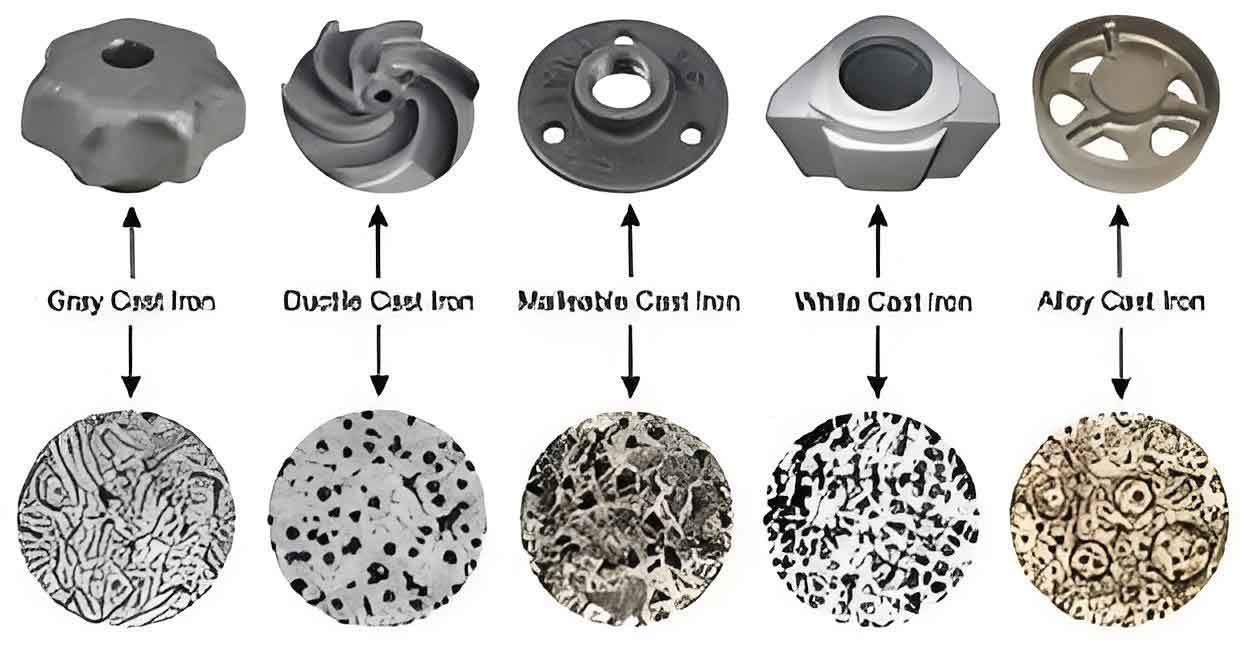
Heat treatment processes are employed to enhance the mechanical properties and performance of various types of cast iron. These processes involve heating and cooling the material under controlled conditions to achieve desired changes in its microstructure. Here’s an overview of the primary heat treatment processes used for gray, white, ductile, and malleable cast irons.
1. Gray Cast Iron
- Annealing:
- Process: Heating to 800-900°C, holding, and then cooling slowly in a furnace.
- Purpose: Reduces hardness, improves machinability, and relieves internal stresses.
- Normalizing:
- Process: Heating to 850-950°C, followed by air cooling.
- Purpose: Refines the grain structure, increases strength and hardness, and improves uniformity.
- Stress Relieving:
- Process: Heating to 500-600°C, holding, and then cooling slowly.
- Purpose: Reduces residual stresses without significantly affecting mechanical properties.
2. White Cast Iron
- Annealing:
- Process: Heating to 800-900°C, holding, and then slow cooling.
- Purpose: Converts cementite to graphite (temper carbon), making the iron more machinable.
- Hardening and Tempering:
- Process: Heating to 850-950°C, quenching in oil or water, and then tempering at 200-400°C.
- Purpose: Increases hardness and wear resistance while reducing brittleness.
- Stress Relieving:
- Process: Heating to 500-600°C, holding, and then cooling slowly.
- Purpose: Reduces residual stresses, improving dimensional stability.
3. Ductile Cast Iron
- Annealing:
- Process: Heating to 850-900°C, holding, and then cooling slowly.
- Purpose: Improves ductility and machinability by promoting a more uniform microstructure.
- Normalizing:
- Process: Heating to 850-950°C, followed by air cooling.
- Purpose: Increases strength and hardness by refining the grain structure.
- Austempering:
- Process: Heating to 850-950°C, quenching in a molten salt bath at 250-400°C, and then air cooling.
- Purpose: Produces a bainitic structure, improving strength, toughness, and wear resistance.
- Stress Relieving:
- Process: Heating to 500-600°C, holding, and then cooling slowly.
- Purpose: Reduces residual stresses without significantly altering mechanical properties.
4. Malleable Cast Iron
- Annealing (Ferritizing):
- Process: Heating to 900-950°C, holding for an extended period, and then slow cooling.
- Purpose: Converts combined carbon to temper carbon, making the iron ductile and malleable.
- Normalizing:
- Process: Heating to 850-950°C, followed by air cooling.
- Purpose: Refines grain structure and enhances mechanical properties such as strength and hardness.
- Stress Relieving:
- Process: Heating to 500-600°C, holding, and then cooling slowly.
- Purpose: Reduces residual stresses and improves dimensional stability.
Summary of Heat Treatment Processes
| Cast Iron Type | Heat Treatment Process | Temperature Range (°C) | Purpose/Effects |
|---|---|---|---|
| Gray Cast Iron | Annealing | 800-900 | Reduces hardness, improves machinability |
| Gray Cast Iron | Normalizing | 850-950 | Increases strength and hardness |
| Gray Cast Iron | Stress Relieving | 500-600 | Reduces residual stresses |
| White Cast Iron | Annealing | 800-900 | Converts cementite to graphite |
| White Cast Iron | Hardening and Tempering | 850-950 (quenching), 200-400 (tempering) | Increases hardness, reduces brittleness |
| White Cast Iron | Stress Relieving | 500-600 | Reduces residual stresses |
| Ductile Cast Iron | Annealing | 850-900 | Improves ductility and machinability |
| Ductile Cast Iron | Normalizing | 850-950 | Increases strength and hardness |
| Ductile Cast Iron | Austempering | 850-950 (quenching), 250-400 (salt bath) | Improves strength, toughness, and wear resistance |
| Ductile Cast Iron | Stress Relieving | 500-600 | Reduces residual stresses |
| Malleable Cast Iron | Annealing (Ferritizing) | 900-950 | Converts combined carbon to temper carbon |
| Malleable Cast Iron | Normalizing | 850-950 | Refines grain structure, enhances strength and hardness |
| Malleable Cast Iron | Stress Relieving | 500-600 | Reduces residual stresses |
Detailed Process Descriptions
- Annealing:
- Used to soften cast iron, making it more machinable and relieving internal stresses. It also homogenizes the microstructure, resulting in improved mechanical properties.
- Normalizing:
- This process refines the grain structure and enhances mechanical properties such as strength and hardness. Normalizing is particularly beneficial for components that require uniform mechanical properties.
- Austempering (for Ductile Iron):
- Produces a bainitic microstructure, offering an excellent combination of strength, toughness, and wear resistance. Austempering is often used for high-performance applications.
- Hardening and Tempering (for White Iron):
- Enhances wear resistance by increasing hardness, while tempering reduces brittleness to some extent. This process is essential for parts subjected to high wear and impact.
- Stress Relieving:
- Reduces residual stresses induced during casting or machining. This process is crucial for maintaining dimensional stability and preventing warping or cracking during service.
Heat treatment processes are tailored to optimize the performance of each type of cast iron, ensuring they meet the specific requirements of their applications.
